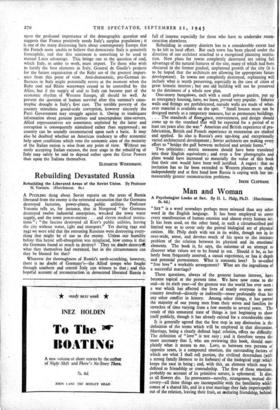Rebuilding Devastated Russia
A PUZZLING thing about Soviet reports on the areas of Russia liberated from the enemy is the reiterated accusation that the Germans destroyed factories, power-plants, public utilities. Professor Voronin tells us, for instance, that in Novgorod " the Germans destroyed twelve industrial enterprises, wrecked the town water supply, and the town power-station . . . and eleven medical institu- tions " ; " the fascists destroyed all Kiev's public utilities, leaving the city without water, light and transport." Yet during 1941 and 1942 we were told that the retreating Russians were destroying every- thing that might be of use to the enemy. Unless our humility before this heroic self-abnegation was misplaced, how comes it that the Germans found so much to destroy? They no doubt destroy what they themselves had recreated, but in the circumstances can they be blamed for that?
Whatever the thoroughness of Russia's earth-scorching, however, there is no doubt of Germany's—the Allied troops who fought through southern and central Italy can witness to that ; and this hopeful account of reconstruction in devastated liberated Russia is full of interest especially for those who have to undertake recon- struction elsewhere.
Rebuilding in country districts has to a considerable extent had to be left to local effort. But each town has been placed under the direction of one architect attached to a recognised planning institu- tion. New plans for towns completely destroyed are taking full advantage of the natural features of the site, many of which had been obscured in the former gradual, unplanned growth of the city (it is to be hoped that the architects are allowing for appropriate future development). In towns not completely destroyed, replanning will include what is worth preserving, especially in the case of cities of great historic interest ; but one old building will not be preserved to the detriment of a whole new plan.
One-storey bungalows, each with a small private garden, put up as emergency housing, have, we learn, proved very popular. Interior walls and fittings are prefabricated, outside walls are made of what- ever material is available on the spot. " Small houses must not be designed merely as a temporary measure, but as permanent buildings. . . . The standards of floor space, conveniences, and design should come up to the standard that will be expected fos a period of at least ten years after the war." American and British experience of pre- fabrication, British and French experience in restoration are studied and applied. So also is Russia's own age-long and exceptionally varied architectural development ; Soviet architects are making every effort to " bridge the gulf between technical and artistic forms."
Two criticisms : metric measures should have been translated into their English equivalents ; and even a few photographs and plans would have increased so materially the 'value of this book that their cost would have been well justified. A regret: that no invitation has so far been extended to Western planners to study independently and at first hand how Russia is coping with her im- measurably greater reconstruction problems.
IRENE CLEPHANE.






















 Previous page
Previous page